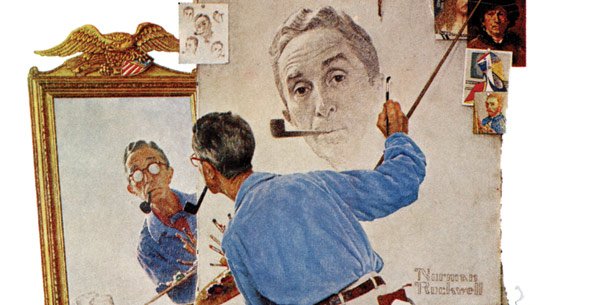An Overview of Norman Rockwell
Norman Rockwell: Who Was He?
Norman Rockwell was a storyteller as much as a painter. Rockwell, one of America’s most adored illustrators, was born in New York City in 1894 and is renowned for encapsulating the essence of the American experience. His art brought aspects of ordinary American life to life, from Boy Scouts to family dinners.
The Legacy of Rockwell in American Art
His work struck a chord due to its emotional depth more than its technical mastery. For many years, The Saturday Evening Post’s covers featured Rockwell’s illustrations. But out of all his paintings, “Triple Self-Portrait” is particularly noteworthy for its inventiveness as well as the insight it provides into the artist.
Comprehending the Self-Portrait Concept
A Self-Portrait: What Is It?
An artist painting their own face is only one aspect of a self-portrait. It’s a behind-the-scenes look at identity research. Artists reveal their personalities, perceptions, and perhaps their vulnerabilities through self-portraits.
The Personal Aspect of Self-Portraiture
They resemble visual diaries in certain ways. Every brushstroke has the potential to convey either assurance or uncertainty. Painting himself represented a rare moment of self-reflection for Rockwell, whose art was frequently romanticized and hopeful.
The History and Inspiration of the Well-Known “Triple Self-Portrait” Artwork
Rockwell made “Triple Self-Portrait” as a Saturday Evening Post cover in 1960. Don’t be duped, though; this wasn’t a ploy. It was a deft, multi-layered method for Rockwell to express, “This is how I see myself… and how I believe others see me.”
An explanation of the painting
The artwork depicts Rockwell painting his own reflection in a mirror while seated on a stool. However, what we, the viewers, see is intriguing: the mirror reflects Rockwell’s face, he sits with his back to us, and his painting-in-progress depicts a more youthful, idealized version of himself.
Symbolism and Unspoken Information
The game of perception is brilliant. Clipped pictures of well-known artists, like Dürer, Van Gogh, Picasso, and Rembrandt, hang around the canvas like critics or muses. “This takes serious focus,” he says, pushing his spectacles up to his brow. Every detail entices you to examine it more closely.
Techniques Employed in Art: Perspective and Composition
Rockwell has a very careful layout. The term “Triple Self-Portrait” refers to the triangle of perspectives formed by the several reflections. It invites you to follow his line of thought, much like a mirror maze.
Utilizing Lighting and Color
He blended depiction and reality with gentle tones. Dream and reality are separated in the picture by the chilly blues and grays that accentuate the warmth of his golden skin tone.
Wit and Humor in the Artwork
Rockwell couldn’t help but wink. He is expressing, “I know I’m aging, but I still feel young inside,” as evidenced by the fire helmet on the ground, the sketches tacked up, and the exaggerated youthful visage on the canvas.
Historical and Cultural Importance
Through the Lens of Rockwell, American Identity
This painting is cultural as well as personal. It happened in the 1960s, when America was about to undergo a transformation. As the chronicler of American life, Rockwell shifts the focus to himself.
Thoughts from a Time Period
The self-portrait reflects the optimism, nostalgia, and identity crisis of mid-century America. Like Rockwell, the nation was coming to terms with itself.
Interpretation from a psychological perspective
The inner monologue of the artist “Triple Self-Portrait” is almost like an oil therapy session. Rockwell struggled with his age, reputation, and sense of value. He was posing the question, “Do people see me as I see myself?” by painting himself.
Examining Rockwell’s Goals and Insecurities
Rockwell’s decision to depict himself as a younger person suggests a wish to preserve youth or perhaps a critique of how society still expects the classic Rockwell enchantment. It has layers of self-awareness and longing.
Impact on Contemporary Artists’ Remembrances and Parodies of the Piece
Rockwell’s “Triple Self-Portrait” has been praised by innumerable artists in everything from animated series to contemporary graphic novels. It is recognizable. There are parodied versions with cartoon characters, politicians, and superheroes.
Advice for Today’s Artists
The lesson? Tell the truth. Rockwell’s artwork encourages artists to examine themselves and show their mess—rather than simply their polish. We are all vulnerable.
Where to See It Now
Exhibitions and Museums
The Norman Rockwell Museum in Stockbridge, Massachusetts, is home to the original “Triple Self-Portrait.” The trek is worthwhile if you’re a devotee.
Accessibility Using Media and Prints
Unable to travel? Numerous books and movies about Rockwell’s life feature it, and high-quality prints are easily accessible.
Conclusion Regarding Rockwell’s Self-Portrait
“Triple Self-Portrait” by Norman Rockwell is a statement rather than just a picture. It reveals the man behind the paint by removing the layers of notoriety, age, and artistic skill. It is humorous, thought-provoking, and incredibly human—like Rockwell.
In conclusion
Few paintings are able to do what Norman Rockwell’s “Triple Self-Portrait” does: it simultaneously makes you feel, ponder, and grin. This ingenious visual autobiography is as much about the audience as it is about the creator. Rockwell painted his soul in addition to his face. In doing so, he gave us the opportunity to think for ourselves.







